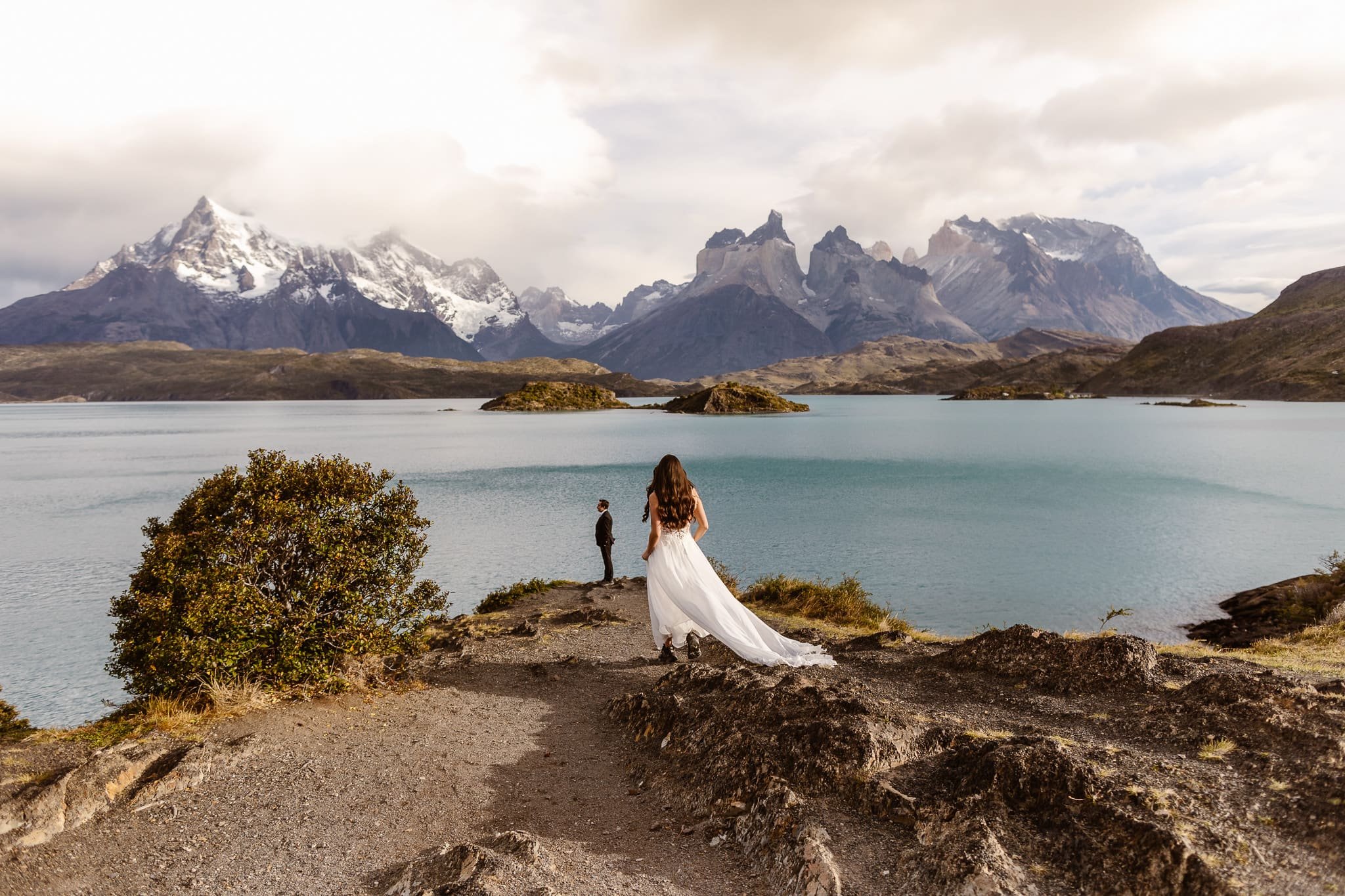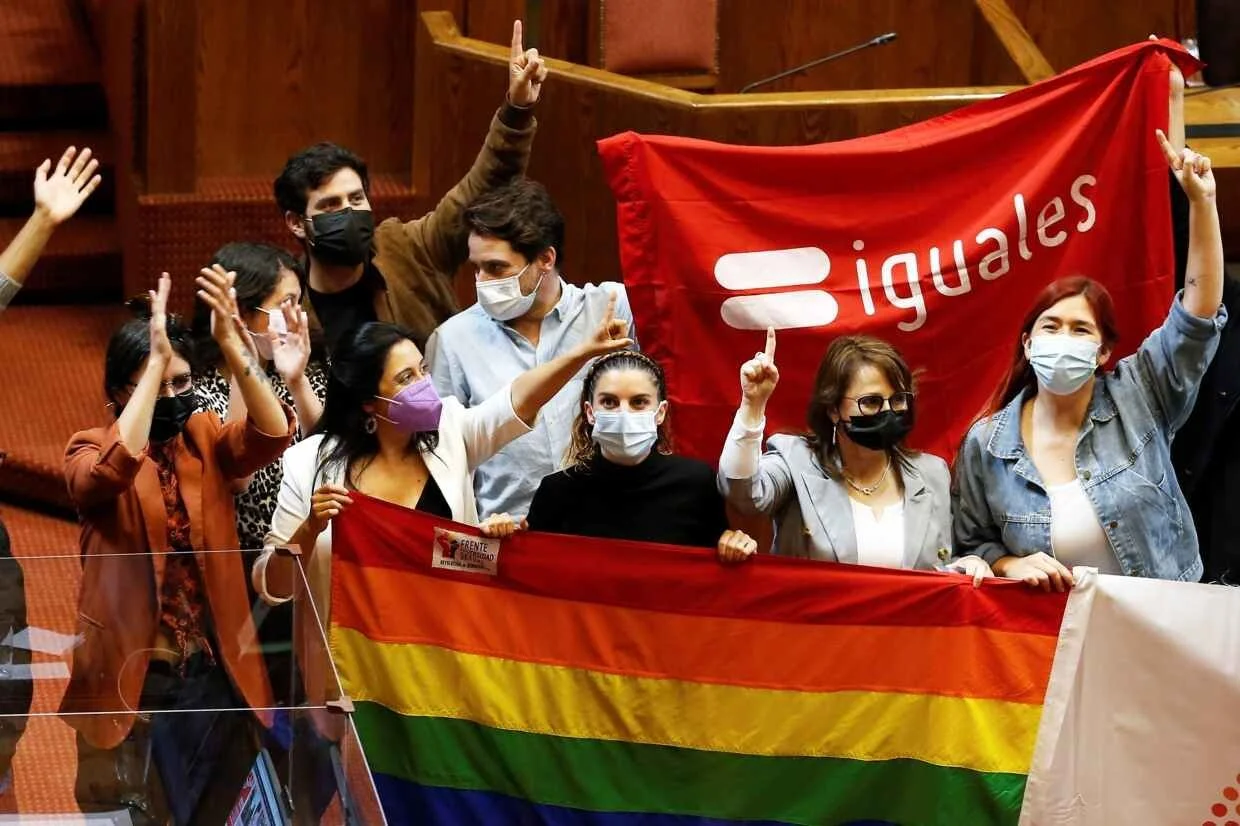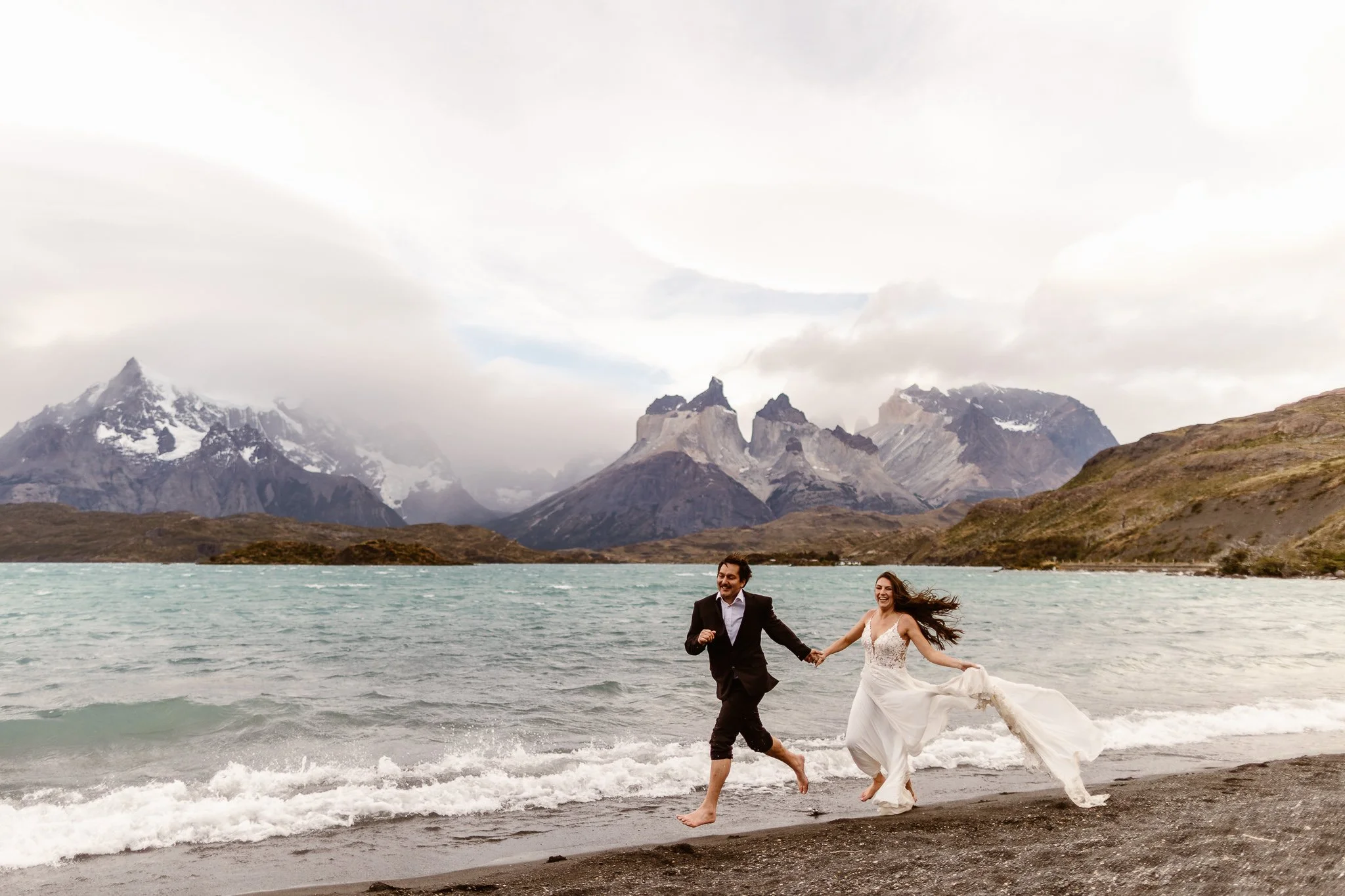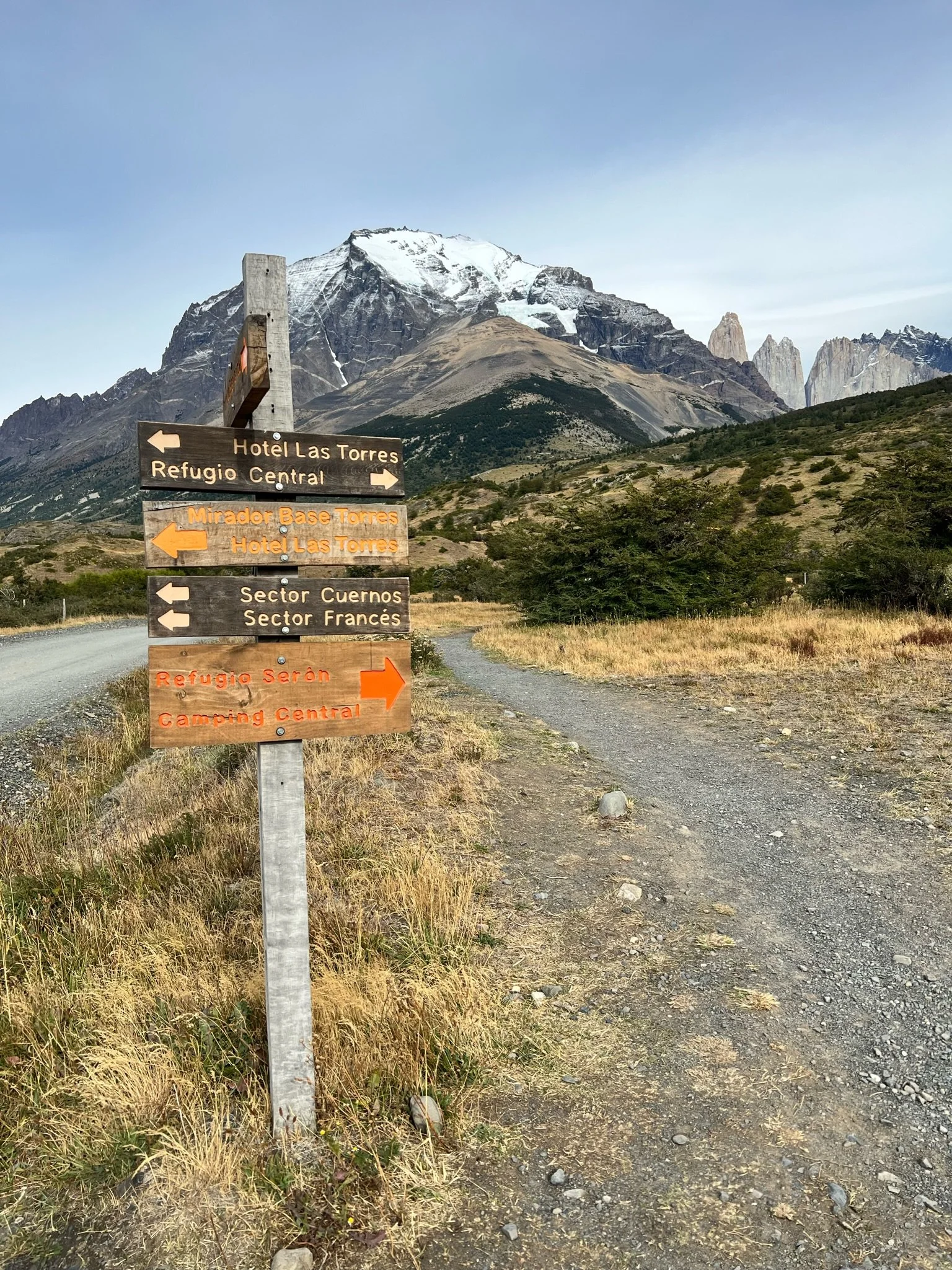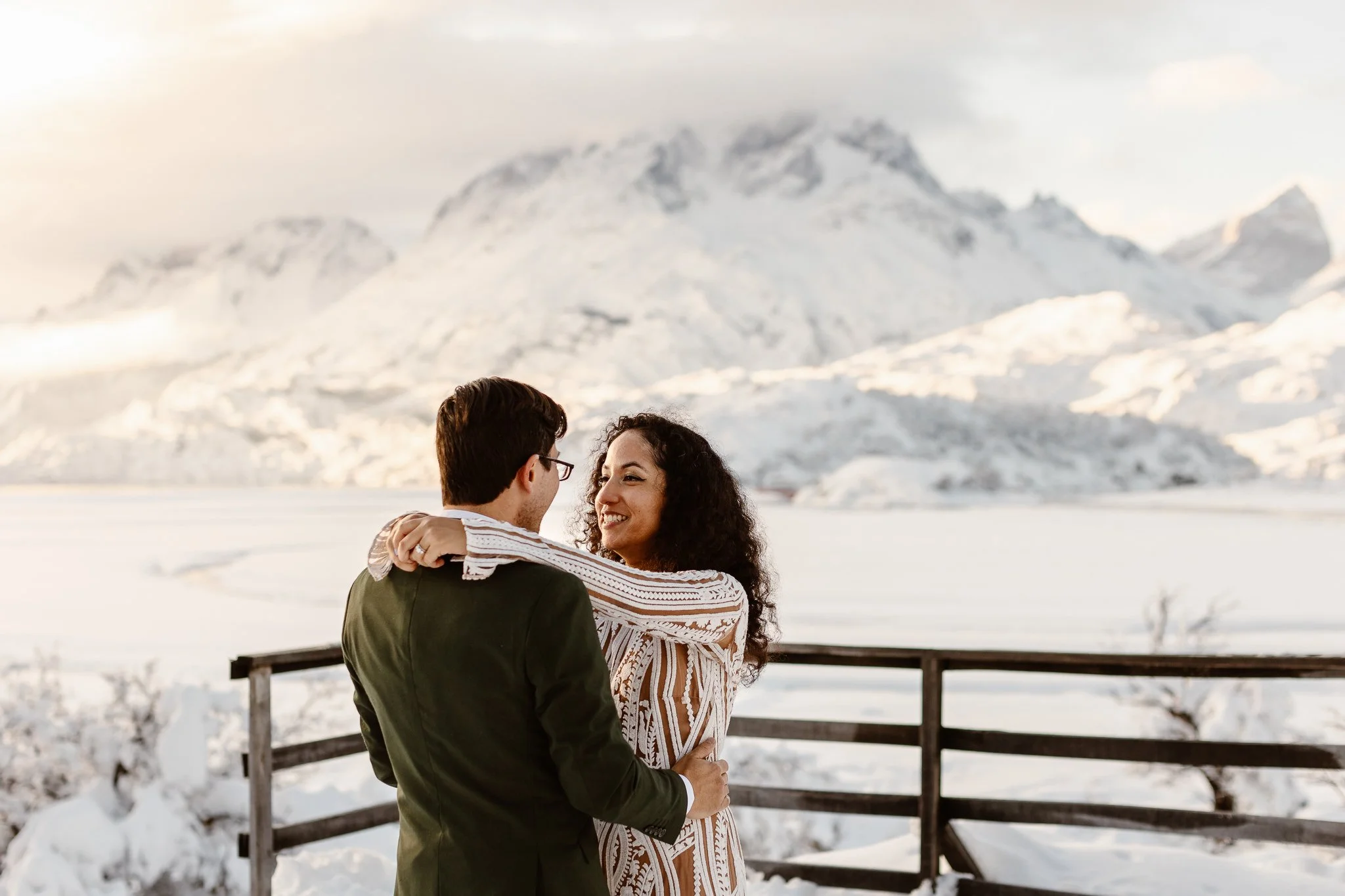How to Elope in Patagonia, Chile | Updated for 2024
Updated March 14th, 2024
Quick note: As an affiliate member for REI, Cotopaxi, VRBO and Amazon, this post may contain links to recommended products or services that I use myself and love. If you make a purchase after clicking one of these links, I earn a small commission (at no extra charge to you). I promise any latte money earned ☕️ will be used to create even more useful content like this! Thank you!
Updated for the 2024-2025 Wedding Season
A Patagonia Elopement Photographer’s Guide to Everything You Need to Know
Table of Contents
Patagonia, Chile.
The first time you said it, it was with a little smile in a casual way. Just in case your partner laughed and then you could laugh too. And then the two of you would talk about other places more… practical.
But he didn’t laugh. He smiled back.
Your mind and imagination conjured up where Patagonia existed—a narrow slip of rocky magic enshrouded in mist at the bottom of the world. Where Antarctic-kissed waters roll onto pebbled shores and pumas slink from one hiding spot to the next.
You picture how you’ll vow to love him until the end of time under a lavender sky. Your nose and cheeks are pink with excitement and the bracing cold. He holds your face in his warm hands and looks at you as he vows the same. It’s perfect. It’s Patagonia.
And its enchantment will stay with you forever.
If you’re prepared to have your wedding on the trail to land’s end, your feet encased in sturdy boots and hair flowing in the wind at 7,000 feet, keep reading. Your journey to the adventure wedding of your life, captured in striking Patagonia photography, is about to begin.
Eloping in Patagonia—You Need an Expert
As a Chilean native, Patagonia is part of who I am. I am an expert in Patagonia elopements and can help you plan the intricacies of your dream elopement here.
Photographer Andrea Enger enjoying a misty view of the Torres (“the towers”) in Torres del Paine national park.
I moved from Chile to the United States in my 20s and to Colorado in 2013. I frequently travel back to Chile and am well-versed in the details required to navigate Patagonia's vast, breathtaking region.
The fine details are an essential component of successfully arriving in Patagonia! One of the most popular destinations for Patagonia elopements is Torres del Paine. During the summer season (winter in the United States), there are regular flights from Santiago, Chile, to Puerto Natales, Chile. Then, it’s another 2-hour drive to the national park.
Flying to Punta Arenas is also an option. However, while many enjoy making a stop here—it’s the southernmost large city in the world—reaching Torres del Paine is an additional 5-6 hour drive.
It is essential to understand that Patagonia is incredibly remote. However, this is all part of the lure of the region. The adventure begins at take-off!
What Makes Me Qualified?
With a decade of experience as a travel elopement photographer, I understand how to help you reach your destination and keep your special day on track. Cold hands or a hot spot on your ankle from hiking to that perfect spot? I’ve got you covered with hand warmers and a bandaid. Did I mention I’m also CPR and first aid certified?
I also place a high value on inclusivity. As a Latina, my culture and identity are key tenets of my identity. I celebrate the diversity of all body shapes and sizes and celebrate love for the sake of love. Same-sex marriages are welcome and supported here! (More on that below.) As your travel elopement photographer, I aim to tie in the elements of who and your partner are in one-of-a-kind locations.
What to Expect with your Patagonia Elopement
As an elopement photographer who was born and raised in Chile, I’ve always loved how mystical and ancient Patagonia looks—whether it’s a bright, sunny day with a big blue sky or a moody, gray one. It’s almost a place that time forgot. Much of it has remained as wild, isolated and unspoiled as when only the Patagonians lived here.
But before the arrival of the Europeans, the Patagonians hunted and paddled the fjords, or narrow sections of sea typically formed by melting glaciers, by canoe. The Chilean government is focused on preserving the heritage of the Indigenous people of Patagonia and land conservation.
Thanks to these conservation efforts, the landscape here has remained pretty spectacular. The golden grasslands, lush rainforests and heather mountain peaks will create a stunning natural background for elopement photography you’ll treasure forever.
Chilean Heritage + Culture
In Chile, our national language is Spanish and our heritage is a mix of Indigenous and European. Our cuisine is Spanish-influenced and prepared with fresh, local ingredients, meat and seafood. Some of our specialties are empanadas, which are pastries typically stuffed with meat and cheeses.
You’ll also find us warm and welcoming no matter when you visit. And any time is excellent for Patagonia photography, as each season has its own amazing beauty.
Where to Elope in Patagonia
Speaking of beauty, let’s talk about Patagonia wedding venues. This is my favorite part about being a travel elopement photographer because this is where your new adventure starts.
The Patagonian Landscape
Imagine exchanging vows next to an ancient glacier, a stories-high waterfall splashing into a turquoise pool, a snow-peaked summit, or a pretty mountain meadow. Or any other spot that’s so achingly beautiful, you’ll have to pinch yourself to make sure your elopement is really happening. Again, that’s where I come in to help you piece together your Patagonia wedding vision.
We’ll take your wedding adventure step by step, letting Patagonia’s energy pull you to the small sweet spot in this magnificent space where you’ll finally make your promises to each other. It may not be traditional. You may not even be in a gown and you definitely won’t be in Jimmy Choos. But what you’ll have is an epic adventure to remember forever—together.
In a way, this hard-earned, high adventure wedding may be the easiest. Because you’ll have an expert local in me to guide you—you knew I am Chilean, right? Contact me and let’s talk about how you can start your life together in legendary, wild, and romantic Patagonia.
Planning Your Patagonia Elopement
A starkly beautiful granite wilderness, Patagonia is a special landscape. Imagine the colors—the azure of the lakes, the cliffs of slate, and a lavender sky at dusk. A Patagonia elopement at the ends of the earth? Stunning... and symbolic. Certainly an adventure for which you’ll need a sense of discovery and a bit of humor. The hikes to breathtaking summits combined with the unpredictable elements will also require sturdy gear whether you’re overnighting on the trail or staying in one of the luxury hotels available.
But, here’s why this experience will be different with me. With my personal experience and extensive knowledge of Patagonia, I can serve as your wedding photographer and your guide before, during, and after your journey. Together we can plan your epic wedding day.
Booking me to document your international elopement means you’ll get access to my Client Resources that outline the gear you need, the travel requirements and expectations, and the overnight options that will make your elopement both romantic and adventurous. This guide shows just a snippet of the information I provide for planning a trip of this magnitude.
The Legal Side of Your Patagonian Wedding
It’s important to know that it’s best (AKA easiest) to get legally married in your country of origin and hold the ceremony in Chile or Argentina.
If you really want to get legally married in Patagonia and do all the official paperwork abroad, ask me for more details, but understand that it involves visiting the US Embassy in Santiago after your “civil ceremony,” potentially adding more time to your trip, as well as bringing along birth certificates and other sensitive original documents. It is possible, but far less common. Be sure to share your plans with me in our initial consultation, and know that I’m here to answer any questions you may have.
Same-Sex Marriage in Chile
As of 2022, same-sex marriage is legal in Chile. In 2021, the country’s conservative president surprisingly passed the law, which came into effect on March 10, 2022. While same-sex couples had been able to enjoy the legal benefits of civil unions since 2015, they still encountered inequality relating to children and their care. Under the new law, both partners are now able to get legal recognition as parents. ¡Órale!
Best Months to Elope in Patagonia
Every season has its challenges as well as desirability. And since Patagonia is less than 1,000 miles from Antarctica, big changes in weather are the norm no matter when you go. The seasons in South America are reversed to North America. But, just like a Colorado elopement, summer and winter are high seasons as many Chileans will vacation then.
The best months to elope in Patagonia are during their summer. The end of November to February are usually mild with the average temperatures in the 60s and cooler nights. Skies will be a beautiful blue and clear too. You’ll have a good chance of a few days of gorgeous weather with plenty of sunshine. If you extend your stay to at least a couple of weeks, you can enjoy all the outdoor activities and hiking there is to do. It’s worth noting though that summer in Patagonia is also known for high winds.
Summer Activities for your Patagonia Elopement:
Rent bicycles and experience El Chaltén on two wheels
Go on a multi-day hike to Mount Fitz Roy
Visit one of the many turquoise alpine lakes for incredible photos
Walk out onto the mesmerizing glaciers in Parque Nacional Los Glaciares
Discover the Magellan Straits and Cape Horn and see whales up close!
View wildlife, like the penguins colonies anywhere from Punta Arenas to Tierra del Fuego
Cruise Patagonia's dramatic coastline and fjords by boat
Explore caves like Argentina’s Cueva del Milodon and discover remains of a saber-toothed cat and even early humans
Madi + Lucas’ summer elopement (late February) in Torres del Paine, Patagonia
Autumn (March to May), is another nice time to visit as the crimson colors of the leaves will be contrasted against the ice-blue lake waters. Again, you’ll find the winds way more moderate than in the summer. Animals will be more active then too, so you may get a better chance of glimpsing some wildlife.
Winters (June to August) are wetter, snowier and often harsh. If you love snowy, dramatic winterscapes and solitude, this might be a good time to visit. There won’t be much, if any greenery. But the winds will be calmer and you may finally spot that elusive puma.
Blanca + Greg’s winter micro-wedding (July) in Torres del Paine, Patagonia
Springtime (October to November) will have warm days with cold nights and a lot of rain. Winds are moderate and temperatures will range from lows in the 30s and highs in the 60s. This is the low season with fewer crowds and more wildlife and plants.
Patagonia’s History
Patagonia’s history is as rich and diverse as the landscape. Numerous indigenous groups lived in Patagonia before the first European explorers arrived. The main groups were the Tehuelche, Selk’nam, Yaghan, and Kaweskar.
An Ancient Land…
Stone tools and human skeletons dating back 12,000 years give us an idea of how early the region was occupied. The Tehuelches were among the early inhabitants. Their numbers and culture, along with those of other indigenous societies, dwindled dramatically after European colonists arrived in the 19th century.
One of the indigenous groups, the Kaweskar, was known for their easily moveable dome-shaped homes and ability to leave no trace. EcoCamp Patagonia, one of the hotels I recommend, has sustainable dome-shaped lodgings inspired by them.
Ferdinand Magellan was the first European explorer to Patagonia, followed by the Dutch in the early 1600s. Argentina’s Cape Horn is named after a Dutch explorer’s hometown, Hoorn.
…Alive With Legends
Hundreds of years passed between Magellan’s visit in 1520 and other travelers. However, the 1850s saw a Welsh expedition venture into the interior of Patagonia. Legend has it the Welsh explorers first coined the term “penguin” from the Dutch words “pen” and “gwyn.” They believed the birds were the resurrected souls of drowned sailors.
The Baqueanos, also known as Chilean cowboys, were essential to the start of Patagonia’s tourism in the 1800s. They led British aristocrat Lady Florence Dixon in 1879. She later wrote a book titled Across Patagonia. In it, Lady Dixon expressed the vastness and wildness of Patagonia.
If you dream of unparalleled adventure for your wedding day, filled with unique wildlife, rich culture, and breathtaking landscapes, read on to learn more about how to turn your dreams of a Patagonia elopement adventure into a reality.
How to Travel to Patagonia, Chile
You’ll find Patagonia on the southernmost edge of the Americas. Its realm is divided over two countries and bisected with the epic Andes, one of the world’s longest mountain chains. The Argentina portion is characterized by windswept grasslands and desertscapes, while the Chile side holds Patagonia’s glaciers and rainforests.
The rugged, stark beauty of the terrain makes an incredibly scenic and romantic background for eloping in Chile. Yes, you can have a Patagonia destination wedding. And yes, it will be unforgettable and adventurous—just like a life together ought to be.
Entering Chile
You’ll need a passport for entry in Chile. If flying in, you’ll most likely arrive at Santiago’s Arturo Merino Benitez International Airport (SCL). U.S. citizens don’t need visas and you can stay up to 90 days.
Upon arrival, you’ll be given a tourist card. If you enter through the airport and you are a U.S. citizen, sometimes you’ll need to pay a “reciprocity fee.” These sorts of fees can change (as of 2022, the $160 fee requirement has been removed, case in point), but a Patagonia elopement photographer like myself knows the latest information and am more than happy to discuss entry requirements with you. At any rate, make sure your passport is valid for at least six months past your entry date. And note, if you’re staying anywhere in South America for work or study, the requirements will be different. You can find more information on the U.S. State Department’s website, too.
*Important Note: If traveling with your kids: In an effort to prevent international child abduction (ok yes, awesome!), Chile has strict requirements for the entry/exit of minors under the age of 18. Even when the minor is traveling with both parents, the parents will be required to show evidence of their relationship to the child when departing the country. Please carry an original—or authenticated—birth certificate.
Getting to the Patagonia Region
The best way to enter Patagonia is through the port town of Puerto Natales, about 1,700 miles south of Santiago. This sweet coastal town is a great base for touring Torres del Paine National Park. The town is a modest one with some restaurants, inns and homes. But you’ll find seafood fresh and deliciously prepared, and the views of the sea and glaciers lovely.
Puerto Natales has an airport too, so you can fly in from Santiago in little more than three hours. If this option is not available, check Punta Arenas. From Punta Arenas, you can take a bus into Puerto Natales. The total travel time to Puerto Natales from Punta Arenas by plane then bus is eight to nine hours.
Other ways to get to Puerto Natales from Santiago is by bus at a duration of 42 hours with a couple of stops and an equipment change or by a combination of train and bus at a duration of 44 hours.
You can also rent a car (I recommend a 4x4) for the truly unique experience of a Patagonia road trip. The area is mostly rural with little crime, and the people living there are relaxed and friendly. Seatbelts are law and you drive on the right and overtake on the left. It’s not necessary to bribe our police here if you are stopped.
Parts of the Carretera Austal and Ruta 40 highways that will take you through northern Chile are unpaved with other stretches more maintained. Watch your speed on the gravel to avoid tire punctures and chipped windshields and you’ll be fine.
And, finally, you can take a ferry tour of Patagonia for the ultimate in slow travel and immersion.
Transportation Options Within Chile
Taxis
Private Transfers
Buses + Colectivos
Trains
Rental Cars/Campervans/4x4s
Ferries
Not sure how you want to proceed? Let’s chat about that together! I know you’ve got questions, and I bet I have answers.
Where to Stay in the Patagonia Region
Puerto Natales
Puerto Natales has a number of hotels and cozy lodges, both in and just out of town. These are just a few of the highly rated ones, but as we start planning your Patagonia elopement, I’ll be sure to send you my more comprehensive list of vetted lodging and BnBs.
The luxurious Singular Patagonia Hotel offers fantastic fjord and mountain views. The property is located in Puerto Bories which is a ten minute drive from Puerto Natales. Rates include a hot breakfast, private bathroom, and all the other comforts of home. They have a lounge for cocktails and their restaurant serves traditional Chilean dishes and grilled meats. The property also has a spa offering treatments, sauna, whirlpool, and indoor and outdoor pools.
Weskar Lodge is highly rated by couples. The restaurant serves excellent seafood and Chilean wines. The rate includes a private bathroom and breakfast with fresh baked goods and fruit. They also offer package rates with breakfast, lunch and dinner, entrance to Torres del Paine National Park, glaciers and transportation. Staff are happy to arrange airport transfers as well.
The 3-star Hostal Andes Patagonicos in Puerto Natales has 15 guest rooms close to the Municipal Historical Museum. Each room has a wardrobe and bathroom. It’s highly rated by couples. There’s no parking, but guests can rent bikes.
Punta Arenas
Most folks will only be passing through Punta Arenas on their way to Torres del Paine, but it’s definitely worth a visit. It’s got something for nature lovers and history buffs alike. Punta Arenas is a small and walkable city but taxis are affordable and easy to hail to get across town.
Hostel Good Vibes is a cozy hostel located in a rustic, 100-year-old building (and named an important cultural heritage site) in the downtown area. Good Vibes has an onsite coffee and pastry shop, a communal kitchen, and a store for any essentials.
Hotel Nogueira is Punta Arenas’ most extravagant hotel and former mansion of sailor José Nogueira (a founder of the town who amassed his fortune through shipping, sea lion hunting and sheep farming). This grand 22-room hotel is now a historic national monument.
How to Get to
Torres del Paine National Park,
Patagonia, Chile
Once you’ve had a comfortable stay in Puerto Natales, you’ll need to get to Torres del Paine National Park, where the entrances to Patagonia are. The best and most economical way to go is by bus. The trip is about two to three hours depending on what entrance you are using. The buses depart Puerto Natales throughout the morning and early afternoon.
Lodging + Camping in Torres del Paine
If you’d like to stay in the park, there are several refugios available. These are full service cabins, with bathrooms and full board, situated along the trails. They come in all sizes, ranging from bunks in a large room to private cabins that are quite nice. Some of them rent camping gear, offer boxed lunches, hot meals, and wine and beer. Often, they serve as gathering places for hikers looking for a beer and conversation at the end of the day.
You can stay in the refugios or huts along the way or camp in tents. Primitive camping in Patagonia is an amazing experience but you’ll have to book far in advance as the best places go quickly. I’m happy to help with recommendations if this is the route you want to take.
One of the best hotels in Torres del Paine National Park (and maybe the world) is the Explora Patagonia. This hotel is an experience as much as a place to sleep. Book your adventures, like hiking and horseback riding, directly at the activity desk. It’s luxurious, modern, beautiful, and one of their all-inclusive stays with magnificent park views would be a fantastic addition to your visit.
Another unique experience is EcoCamp Patagonia, an award-winning dome hotel also located inside Torres del Paine National Park. Explore Patagonia through their guided tours and treks on the W, Patagonia’s most famous hike and quite popular for people staying at the park’s refugios. Or explore the Circuit which is longer and added to the W—an amazing hike with few crowds if you can commit to 8 to 10 days of backcountry life!
We can chat about your expectations and what kind of accommodations will best suit your vision for the ultimate Patagonia elopement experience.
The W, O, and Q Treks in Torres del Paine National Park, Patagonia, Chile
One of the best ways to encounter the true nature of Patagonia is through a trek in Torres del Paine National Park. To experience this ethereal landscape, there are three main treks to consider: the W, O, and Q routes.
Regardless of which trek you choose, for most packages, I typically join you for the first couple of days. Then, the rest of the adventure is up to you! However, if your heart is set on a specific view, I am happy to tag along to your desired destination. My packages are fully customizable.
My goal is to capture your special day the way you envision it. As an elopement photographer, capturing couples beginning their adventure of a lifetime together—their way—is my main goal.
So, if you have a destination in mind, whether it is listed here or not, ask me about it! I would love to work with you to bring your dreams to life.
W Trek
This is Patagonia’s most famous hike. When people think of hiking Patagonia, images from this famous circuit likely come to mind.
At 50 miles long, this trek takes roughly 3-5 days to complete. This route may be more crowded during Patagonia's summer months, but for good reason! You’ll see Grey Glacier, Frances Valley, and the Torres—those iconic, awe-inspiring towers.
O Trek
This trek is also simply known as “The Circuit.” It follows the same route as the W but tacks on an additional 18 miles.
If you’re seeking solitude and can commit to the 6-9 days needed to complete this hike, this may be the hike for you! The extra miles come from circumnavigating the Cordillera del Paine mountains. The O Trek escapes the crowds and provides a unique alternative to the popular W route.
A highlight of this route is glimpsing Lago Paine, a rich, turquoise-blue lake. The O Trek also allows you a view of the mountains from the north. Both sites are enchanting options for photos.
It’s important to note that this route is more challenging, and one part of it, the Paso John Gardener, is sometimes closed due to inclement weather or conditions.
Q Trek
The longest of all, the Q trek includes the O Trek, plus an additional day hike along Lake Pehoe. This trek requires at least 9 days to complete and is the only option allowing a view of the entire Torres del Paine mountain range.
This hike allows views of the Torres del Paine range behind you, coupled with the deep blue of Lake Pehoe. Few hikers trek this added section, so you will likely have much of the trail, and stunning views, to yourselves.
Fitness Level to Trek in Torres del Paine
One of the concerns I hear is: How fit do you need to be to do the W, O, or Q treks? Do you need to be a fitness buff and scale fourteeners easily to do one of these treks? Absolutely not! Most of the hiking challenges come from the distance and changing weather conditions, except for the Paso John Garner at just shy of a 4,000-foot elevation gain. If you dream of a Patagonia elopement, we can design a trek to meet your needs.
Accessibility
And if you require a wheelchair, while it takes a little extra planning, this is entirely doable, too. EcoCamp Patagonia has access to a specially designed wheelchair they helped crowdfund called Joelette. It has one wheel and is stabilized by a person in the front and the back. So while you have to be a guest of EcoCamp, any EcoCamp guest can call ahead and reserve Joelette for their stay.
I’m a firm supporter of inclusivity and am thrilled to help all individuals, regardless of personal abilities, organize their perfect elopement.
Elope in Patagonia, Argentina
Patagonia encompasses a significant portion of South America and, for most people, is the trip of a lifetime. I hope you’ll consider taking the opportunity to look at the Argentine side, which is a bit different from the Chilean side. Maybe you’ll consider eloping in Argentina!
The Argentine Landscape
Where Chile has the temperate, hardwood forests, fjords, glaciers and verdant meadows of Patagonia, Argentina holds the dramatic, starkly beautiful deserts, called steppes, of the region. The Patagonia steppes are large, hilly windswept plains of grasses and shrubs and home to more than 100 species of birds. If you are lucky, you may spot more shy wildlife like foxes and hairy armadillos. Guanaco, cousin to the llama, graze there in herds.
El Chaltén, Argentina
In Argentina, on the edge of the Southern Patagonian Ice Field, you’ll find the perfect village for adventure elopements called El Chaltén. Surrounded by mountains and glaciers, on a plain where the steppe meets valley forest, El Chaltén is the origin point of some of the most exciting hikes in the world.
El Chaltén is famous for its many trailheads that lead to Los Glaciares National Park. You can walk out of your lodging and trek to beautiful lakes, mountains, and glaciers. Then return each evening to your cozy Airbnb or hotel to make your plans for the next day’s adventure—kayaking, mountain biking, or horse riding, anyone? Or, pack your gear and let’s hit the trail for a multi-day trek to see Mount Fitz Roy.
You might recognize Fitz Roy’s iconic peaks as the logo for the Patagonia active clothing company. But this range is also known for its pristine beauty and can only be fully appreciated by heeding its call and hiking toward it. You can reach it on a day hike from El Chaltén or you can explore the many trails over a course of a few days. If you are an experienced hiker, you can make the climb a couple of hours before sunrise from Poincenot campground to Laguna de los Tres viewpoint to see Mount Fitz Roy turn pink as the day breaks.
Flying to El Chaltén is always an option from Buenos Aires. You can also rent a car and drive, although there are some logistics we should discuss as part of our planning.
The End of the World
I can’t miss mentioning Argentina’s historical southernmost province of Tierra del Fuego. There’s even a sign to greet you that says “Fin Del Mundo,” or “End of the World.” The stunning topography is varied with lakes, peaks, forests, grasslands, and glaciers. The capital is the port city of Ushuaia ringed by the Martial Mountains and is a gateway to Antarctica, skiing, and viewing of two penguin species—Magellanic and Gentoo. If you crave adventure, seeing wild penguins, and learning fascinating history and natural science, Ushuaia would be an amazing place to elope.
Sooo… Chile or Argentina?
There are many other areas in Chile that would work perfectly for an elopement. The Region of the Lakes is a zone in the Andean foothills and includes the cities of charming Puerto Varas and lively Pucón. The area is also famous for its national parks of virgin forests and volcanoes capped with snow towering over jade-colored lakes. It would make an ideal place for a honeymoon.
We can talk about which side of the Andes fits your personality and your Patagonia elopement dreams.
Wildlife in Patagonia: What to Expect and Precautions to Take
Regardless of where you elope in Patagonia, the wildlife will captivate you! The wildlife here is as varied as the geography. With patience and knowing where to look, we can strive to capture Patagonia’s iconic animals in your elopement photos. Here are a few animals unique to the area, where to find them, and what to expect.
Guanacos
Guanacos, which resemble alpacas and llamas, are seen year-round. However, they are especially plentiful in Tierra del Fuego. Other places you can find them include Parque Nacional Monte de León, Parque Nacional Torres del Paine, and Parque Nacional Patagonia.
Pumas
Ever elusive, the Patagonia puma once faced near extinction. Due to conservation efforts, the population of this mountain lion has recovered.
These powerful cats are nocturnal and shy. However, you may spot one in Parque Nacional Patagonia, where there are numerous guanacos and wild horses to feast on. Sightings have also occurred at Parque Nacional Patagonia and Parque Nacional Los Glaciares.
Whales, Dolphins + Ocean Wildlife
The waters surrounding the coastal areas of Patagonia are home to four whale species, dolphins, seals, and sea lions. If you dream of watching a magnificent humpback whale breaching over the water, plan your elopement between December to March.
Sightings of the endangered southern right whale happen between July to September. While the magnificent and largest animal on our planet, the blue whale, may be spotted between December to April.
Year-round you can find elephant seals and sea lions. Various dolphin species remain year-round too. So you can often spot them playfully swimming on a whale-watching adventure.
Birds
Patagonia is home to numerous bird species. Popular species include massive condors soaring across the sky, bright pink flamingos, and adorable penguin chicks between November and December.
Here’s a fun fact: when the Magellanic penguins migrate to Patagonia from Brazil to lay their eggs, they outnumber the human population of Patagonia nearly two to one. As a result, three and a half million Magellanic penguins call Patagonia home between October to April. It is quite a sight to see!
Considerations and Safety
Keep in mind that the wildlife in Patagonia is wild! Out of respect for the animals and our safety, we’ll keep safe distances between us and any wildlife we encounter. Leave No Trace principles are also important so as not to disturb animals’ homes.
Should you encounter a puma, it is advised to remain calm and slowly move backwards while looking one straight in the eyes, and to remain upright to appear larger than the animal.
ps. Remember to “Leave No Trace!”
Sustainability can’t just be a niche market for photographers. It must be the new normal! As a nature lover, I am dedicated to helping our earth flourish. This is why I practice “Leave No Trace” principles at each and every one of my sessions.
What Exactly is Leave No Trace?
It is:
🌿 A set of ethics & best practices we should follow to both enjoy and protect
the outdoors at the same time
🌿 An access tool to help enjoy public lands responsibly
and leave less impact
It isn’t:
🌿 Something to shame other people about
or make them feel bad for not knowing
🌿 Something to use to gatekeep and keep others from enjoying the outdoors
Once you’ve booked me as your Patagonia elopement photographer, you’ll receive my full Leave No Trace Guide for couples! It’s an easy-breezy workbook designed to help you plan your dream elopement, while being mindful of the beautiful lands upon which you’ve chosen to exchange your vows.
Final Thoughts…
I’ve always been so inspired by the outdoor beauty, warmth, friendly people, rich culture, and amazing food of my home country. And I believe an elopement in Patagonia would be the ultimate adventure. I know this part of the world so well. I would love to share it with you and help you plan your elopement and photography in either Chile or Argentina. Contact me and we’ll get started planning the most romantic adventure of your lives in a place that’s close to my own heart—my home, Patagonia.
Patagonia Elopement Packages
I’m now booking 2024 + 2025 Patagonia elopements! Bookings are extremely limited. View my rates and see what’s included in my Patagonia Adventure Elopement Packages and reach out to snag your spot ASAP! And of course, we can always start with a low key phone call/text sesh if you have any questions at all. (720) 739-0784.
Ready to Celebrate Your Day Your Way?
Find out how I can help make that happen!
If you’re ready to get the ball rolling to secure your photographer (slash international elopement expert) (slash translator) (slash elopement hype man) that’s fantástico! You can do that by filling out the form below, emailing me directly at andrea@andreaengerphotography.com, or by calling or texting me at (720) 739-0784. I look forward to hearing from you!
If you’re still in the research phase, I hear ya one hundred percent! I encourage you to reach out ASAP so we can begin getting to know one another. But in the meantime, here are some additional galleries for you to peruse and get to know my photography style!

